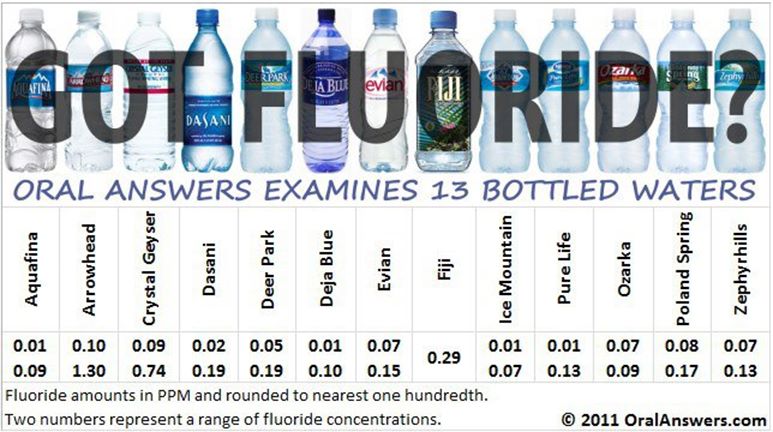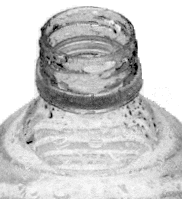|

for the latest in news, events and science on fluoridation.
|
Murky Waters At Home Water is well-known as a keystone to better health. How many times have you heard the proverbial "drink eight 8-ounce glasses of water a day?" Though there is no hard, scientific evidence to support such a statement, and the source of that saying is obscure, it is obvious that you must quench your thirst regularly every day if you wish to stay alive, let alone healthy. Yet, increasingly, the quality and purity of the ordinary water that comes out of your faucet, tap water, is becoming a cause for concern. For decades, scientists have known of the dangers of contamination from lead water pipes, and from the lead solder used in copper pipes and with brass water pipe fittings. Lead pipes were finally banned by the U.S. federal government in 1986. There's also the possibility of ground water contamination from petroleum, pesticides, and other environmental toxins, — especially in rural communities where the majority of drinking water is supplied from wells, and, deliberate contamination with a fluoride chemical in a process called fluoridation. Bacteria, on the other hand, are seldom a worry in North America's municipal drinking water. Municipal water also tends to be "cleaner" since it is run through a strict purification systems and monitored by government agencies. Yet many experts caution against consuming too much tap water. There's a growing body of evidence that some of the very chemicals added to water presumably to guard your health — even chlorine and especially fluoride — may be doing more harm than good.
CHLORINE A 1998 position paper released by Health Canada (the Canadian equivalent of the US Food and Drug Administration) states: "14 to 16 percent of bladder cancers may be attributable to water containing CBPs. There is an urgent need to resolve this. CBPs [may be one of] the most important environmental carcinogens in terms of attributable cancers." The study, Safe Drinking Water: A Public Health Challenge, also links CBPs with spontaneous abortions, birth defects, respiratory problems and spina bifida. When Fluoride is added to the mix, it enhances the probability that tap water may be a danger to the health of a significant subset of the population. In 1992, the American Medical Association published statistics showing nearly 28 percent of all cancers of the intestines and 18 percent of all cancers of the bladder can be traced to chlorinated water. More than a dozen subsequent studies confirm this finding. In 1998, for instance, the journal Epidemiology published a study showing that men who drink chlorinated tap water for more than 40 years face double the risk of bladder cancer compared to men who drink non-chlorinated water. The US Environmental Protection Agency (EPA) reports that THMs are present in virtually all chlorinated water. "We're working very hard to achieve a balance between the need for safer water and the importance of disinfecting the water" EPA spokeswoman Robin Woods says. The agency has ordered cities and towns across the United States to start reducing levels of this compound in drinking water — but chlorination continues unabated, even though water can also be disinfected with ultraviolet light or ozone without creating CBPs. Ozone is used in some European cities — Amsterdam, Paris, Berlin, Munich — in Canada, Kamloops, BC, Montreal, QC, and others — but chlorination continues to be the norm on this continent.
FLUORIDE "You may as well swish with fluoridated tap water and spit it out. That's how it works," Limeback says. Over a dozen Nobel Prize-winning scientists have long warned of a link between fluoride and serious health problems. However, the late Dean Burk, PhD, former chief chemist at the U.S. National Cancer Institute, described fluoride's risk in the starkest terms. After co-conducting the largest U.S. fluoridation epidemiological study in U.S. history, Dr. Burk concluded: "Fluoride causes more cancer, and causes it faster, than any other chemical." He even testified as much is a U.S. Court of law. Fluoride is further linked to osteoporosis, hip fracture, kidney disorders, memory and neurological impairment, not the least of which is Alzheimer's, dementia and Parkinson's disease. U.S. Federal law forbids the EPA from taking a public position for or against fluoride, but the EPA employees union is not similarly restricted. "Our union — comprising several hundred toxicologists, other scientists and lawyers — maintains its solid opposition to fluoridation," says J. William Hirzy, the union's senior vice-president, Congressional Hearings, 2000. According to the Ontario Drinking-Water Systems Regulation O. Reg. 170/03, for the city of Ottawa, Canada's capital, "fluoridation (HFS)" is the final step in its water treatment processes.
It clearly states in its 2013 annual report on page 3 that: That same report also says the following: "List all water treatment chemicals used over this reporting period [Jan 1 - Dec 31, 2013]Page 14 of the report clearly states that: It is important to note that fluoride and chloramine are intentionally added to be present at greater than half the MAC in order to be operationally effective.
SAFE ANSWERS Some people think boiling removes impurities. But boiling actually concentrates substances — as anyone who has left soup boiling too long on the stove knows. The longer any liquid boils off steam, the less water remains to hold the dissolved chemicals and metals. Due to the particular properties of Chlorine and Fluorine, boiling water tends to cause the Chlorine to vaporize, whereas it concentrates the Fluorine in the water. The same thing applies to just letting the water sit on the counter for a while: much of the Chlorine will vaporize out of the water, as those who own pools can attest to, but the Fluorine does not. Peculiarly, quality distillers that use the hydrologic principle of distillation removes 100% of the Fluorine ion from the water! That's chemistry for you.
One really safe option is distilled water and a second not quite as good but better than nothing at all is reverse osmosis (RO) water. RO water is produced using a semi-permeable membrane and pressure to filter out impurities. Critics argue these processes also remove beneficial minerals, but water is a relatively poor source of minerals anyway. In both these cases, the quality of the output water depends largely on the quality of the equipment. Then there's bone char Fluoride water filtration that may remove more than 99% of the Fluoride ion from the water. That's great news for country and city folks alike. Many drilled wells may have as much as 5 ppm Fluoride in their water depending on where they live so it's always best to have well water tested regularly for its fluoride content, both before it enters your filtration system and after it is filtered. So, the next time you turn on the tap, you may want to ponder exactly what's coming out with the water. If you don't know, don't trust it. Remember, there are safer alternatives. Bottled water can contain high levels of fluoride. Instead, choose brands that clearly indicate a fluoride content of 0.1 parts per million (ppm) or less. Here's a sampling of U.S. bottled water brands that claim to be fluoride-free:Apani Purifie — Aqua Panna — Aquafina — Arrowhead — Calistoga Spring — Crystal Geyser — Dasani — Deer Park North — Deer Park South — Great Bear — Hinkley & Schmidt — Ice Mountain Keeper Springs — Loon Country Natural Spring — NARA International Himalayan Spring Ozarka — Penta — Poland Spring — Snow Valley Mountain — SparklettsHere again, testing for Fluoride level is your only guarantee of getting the lowest Fluoride content possible. The same brand from different towns or cities that may be from different sources may not have the same Fluoride ion levels. So, let the buyer beware (caveat emptor). There are three more difficulty with bottled water.
2. there is a huge environmental impact of disposing of these persistent plastics, and, 3. if the fluoride content is below 0.5 ppm, the supplier is allowed to round down the content and declare it as 0.0 (zero) or no fluoride ion content, though most currently do not do so (September 2013). |
||

|
||
for the latest in news, events and science on fluoridation.

 What about bottled water?
What about bottled water?